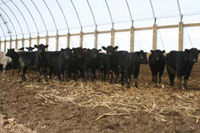Say Buddy, can ya spare a few hundred Thousand?
We all know that the title of this article should not be the opening line of your visit with your lender. However, if you aren’t prepared to show him what he needs to see to be able lend to your operation the capital it needs, that line is about what he hears.
As cattle feeders we are used to and fairly adept at, handling large amounts of capital. The challenge in today’s business climate is that our lenders have to play by a whole new set of rules brought on by the shenanigans (good Irish word for a March article) in the mortgage industry. The topic of access to capital has been a reoccurring one over the past couple of years and seemingly more so in the past 6 months. This prompted us to visit with our contacts within the Ag lending industry and ask them point blank, “What are you looking for in a business proposal?”
We will be using the addition of 640 head of capacity of the Hoop Beef System to an existing feeding operation as our target discussion. This will be approximately a $300,000.00 project. The goal of the project is to be able to provide enough income producing capacity to bring Junior and his new wife into the farming operation.
- Knowledge and Passion for the project: Your lender wants you to sell him on why YOU believe this is the best avenue for your operation. There is marked difference between the statement to the lender, “Well we were thinking that this might be a good deal and we are hoping that you…..” And “We are going to build 640 head capacity of the Hoop Beef System and here is how we believe the project will work…. and we want you as our lending partner….”
Can you hear the difference? If not read it aloud. Your lender wants you to show him your passion for this project. It shows you did your homework. In this presentation you will need to show your lender: Project Cost Estimates, Closeouts current and projected, Outline your current challenges and why you BELIEVE this is the best solution i.e., Consistency of performance and profitability, Regulation compliance, Reducing Market Risk, Efficiency of Labor etc.
- 2. Records of past performance: Your lender does not want to see just 3 years of tax records, but records from your feeding operation. What is your current feed efficiency? How much improvement can we expect in the new feeding system? How does this system pay for itself over what period of time? In this arena actuals trump projections every time. We are happy to provide to our prospective customers closeouts from our feeding operation as a basis of comparison for your current operation.
- 3. Equity: You can’t borrow every dime for a project. Your lender wants you “to have some skin in the game”. 20-25% equity in the project is fairly standard in today’s world. More or less equity may be required depending on our current financial situation. In our discussion scenario, Junior most likely does not have adequate equity and will rely on the more well-heeled partners to bring that to the table. This is potentially a great way to transfer assets to the next generation, without a whole mess of tax implications.
- 4. Sensitivity Analysis: In laymen’s terms this is laying out the risk factors that can affect the outcome of a scenario and determining which factor has the greatest influence on the outcome. For instance in cattle feeding, the major risk factors are; Feeder Cattle or replacement prices, Feed prices, Sales or market prices, which are all under the broad category Market risks. Another broad category is Production risks including: Death loss, Morbidity or treatments, Weather events, Average daily gain and Feed efficiency. There are also Operational risks which cover: Life Transitions like Death, Divorce, Disability or Departure from the operation. In the sensitivity analysis we layout all these risks and determine which will have the greatest impact on the outcome. Identifying the risks is one step; the next step is laying out the plan to mitigate these risks.
Feeding cattle in the Hoop Beef System mitigates many of these risk factors already. When you put a consistent type of cattle, in a consistent environment, you get consistent predictable results, which allows for better business modeling and planning which reduces Market risks. The System takes care of weather extremes and their corresponding impact on performance, which narrows the production risks to just our management ability to feed cattle well. The only impact the Hoop Beef System has on Operational Risk is that when life happens, know that the learning curve to manage cattle successfully in the Hoop Beef System is relatively short and the next man up can step in and do a great job in short order.
As always, we are open to helping our prospective customers prepare for this conversation and we have the tools and experience to make this as painless as possible. Contact us to schedule a time to lay out your plan and we will help you position your operation for the future.
We Got Ya Covered…Don’t track it in the house.

